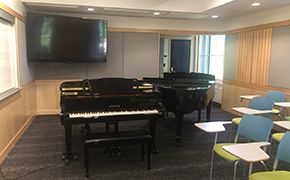Instructor Insights pages are part of the OCW Educator initiative, which seeks to enhance the value of OCW for educators.
Course Overview
This page focuses on the course 21M.260 Stravinsky to the Present as it was taught by Professor Emily Richmond Pollock in Spring 2016.
This course provides an overview of the musical styles and techniques developed over the past 115 years. The anthology and supplemental listening present a range of art music aesthetics in a variety of genres such as chamber music, symphonic and choral music, and opera. Students tune their ears to novel sounds, hone their own preferences and aim to understand the motivations behind and importance of a wide diversity of compositional orientations, including Expressionism, Impressionism, atonality, neo-Classicism, serialism, nationalism, the influence of jazz and popular idioms, post-tonality, electronic music, aleatory, performance art, post-modernism, minimalism, spectralism, the New Complexity, neo-Romanticism, and post-minimalism.
Course Outcomes
Course Goals for Students
- Become familiar with the musical languages developed since 1900
- Listen to music precisely and describe it using appropriate terminology
- Identify and analyze important features in notated scores
- React independently and critically to unfamiliar works to understand how music is shaped by aesthetic, historical, and political motivations
Students’ conversations become the class session. That’s how I teach. There's not a lecture, I don’t hold forth on particular topics for many minutes on end. Students have already done the work. They've completed the readings, looked at the details that I've asked them to explore, and come to class ready to share their reactions. Rather than dispensing information, I spend my time helping students refine their ideas.
— Emily Richmond Pollock
Below, Professor Emily Richmond Pollock describes various aspects of how she teaches 21M.260 Stravinksy to the Present.
Curriculum Information
Prerequisites
21M.301 Harmony and Counterpoint I or permission of instructor.
Requirements Satisfied
- GIR

- CI-M

- HASS

21M.260 may be applied toward a Bachelor of Science in Music or a Bachelor of Science in Humanities and Engineering/Science.
Offered
Every spring semester
Assessment
Grade Breakdown
The students' grades were based on the following activities:
Student Information
Breakdown by Year
Mostly juniors and seniors
Breakdown by Major
Mostly music majors or minors
Typical Student Background
Sometimes students come to a course like this one with a stereotypical bias against modern music, but in this case, that did not occur. Several students considered themselves composers and artists and were particularly excited to learn about twentieth-century music.
› Read More
During an average week, students were expected to spend 12 hours on the course, roughly divided as follows:
In Class
- Met 2 times per week for 1.5 hours per session; 27 sessions total.
- Class sessions were discussion-based, and included warm-ups.
- Joseph Auner, author of the course textbook, was a guest speaker during one of the sessions.
Out of Class
Students completed anthology assignments and supplemental listening exercises, in addition to writing two formal papers and reviews of live events featuring music since 1900.
While the anthology assignments helped students hone their score-reading skills, the supplemental listening exercises, for which I did not provide scores, had purely to do with what students could get from listening alone.
— Emily Richmond Pollock
Semester Breakdown
| WEEK | M | T | W | Th | F |
|---|---|---|---|---|---|
| 1 |  |
 |
 |
 |
 |
| 2 |  |
 |
 |
 |
 |
| 3 |  |
 |
 |
 |
 |
| 4 |  |
 |
 |
 |
 |
| 5 |  |
 |
 |
 |
 |
| 6 |  |
 |
 |
 |
 |
| 7 |  |
 |
 |
 |
 |
| 8 |  |
 |
 |
 |
 |
| 9 |  |
 |
 |
 |
 |
| 10 |  |
 |
 |
 |
 |
| 11 |  |
 |
 |
 |
 |
| 12 |  |
 |
 |
 |
 |
| 13 |  |
 |
 |
 |
 |
| 14 |  |
 |
 |
 |
 |
| 15 |  |
 |
 |
 |
 |
| 16 |  |
 |
 |
 |
 |
 No classes throughout MIT
No classes throughout MIT Class session
Class session Guest speaker
Guest speaker Writing requirement due
Writing requirement due No class session scheduled
No class session scheduled Student paper presentations
Student paper presentations Listening quiz
Listening quiz


 Room 1 of 1
Room 1 of 1 
 20% Attendance and
20% Attendance and  45%
45%